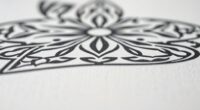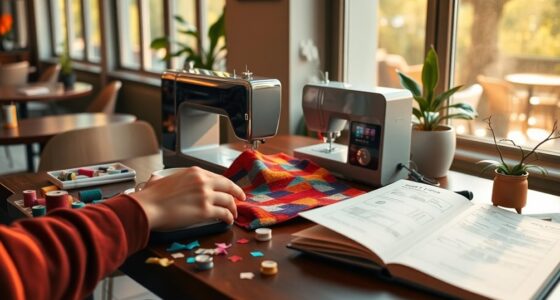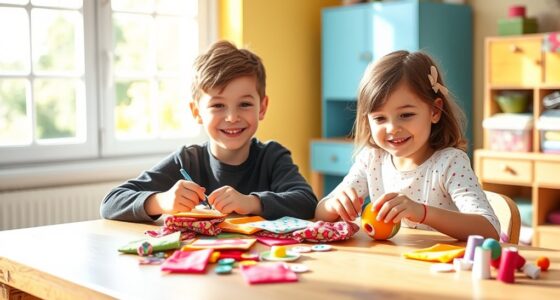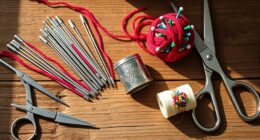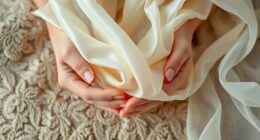Yarn-dyed fabrics are created by dyeing individual yarns before weaving, allowing for vibrant patterns, intricate designs, and better colorfastness. Piece-dyed fabrics are dyed after weaving, resulting in solid, uniform colors that are quicker and more cost-effective to produce. If you want durable, multi-colored textiles with detailed patterns, yarn-dyed fabrics are ideal. To understand which option best fits your project’s needs, explore the key differences and benefits further.
Key Takeaways
- Yarn-dyed fabrics allow for intricate patterns and multi-color designs, while piece-dyed fabrics produce solid, uniform colors.
- Yarn-dyeing offers superior colorfastness and durability, resisting fading and bleeding over time.
- Piece dyeing is faster and more cost-effective, suitable for simple, single-color fabrics.
- Yarn-dyed textiles support complex patterns and subtle shading, ideal for detailed or vibrant designs.
- The dyeing process impacts the fabric’s appearance, longevity, and suitability for high-wash or heavy-use applications.

When choosing fabrics for your project, understanding the difference between yarn-dyed and piece-dyed textiles can considerably impact the final look and quality. Yarn-dyed fabrics are created through fiber dyeing processes, where individual yarns are dyed before they’re woven or knit into fabric. This method allows you to incorporate multiple colors within a single yarn, resulting in intricate patterns, stripes, or checks that are vibrant and well-defined. Because the dyeing occurs at the fiber level, yarn-dyed fabrics tend to have superior colorfastness, meaning the colors are less likely to fade or bleed over time. This durability makes them ideal for items that will undergo frequent washing or heavy use, like upholstery, clothing, or accessories.
Fiber dyeing, the process used in yarn-dyeing, provides a level of control that directly influences the fabric’s overall appearance and performance. Since each yarn is dyed separately, you can achieve complex color combinations and subtle shading effects that are difficult to reproduce with piece dyeing. Plus, because the dye penetrates the fiber thoroughly, the resulting fabric maintains consistent coloration even after multiple washes. This quality is particularly important if you’re aiming for longevity and color retention in your designs. In contrast, piece dyeing involves dyeing the entire fabric after it has been woven or knitted, which generally results in a more uniform color across the surface. While this method is faster and often more cost-effective, it may not offer the same depth of color or durability, especially around seams or edges where wear is concentrated.
Colorfastness is a key consideration when selecting between these two methods. Yarn-dyed fabrics often outperform piece-dyed ones in this regard because the dye bonds more securely at the fiber level. This means the colors are less prone to fading, even after repeated laundering or exposure to sunlight. If your project requires long-lasting vibrancy, yarn-dyed textiles are usually the better choice. Additionally, yarn-dyeing allows for more detailed and multi-colored patterns, giving your design a richer, more textured appearance. While piece dyeing can produce solid, uniform colors efficiently, it may not match the depth and complexity achievable with yarn-dyed fabrics. Understanding the dyeing process and the implications for colorfastness helps you pick the right fabric for your specific needs, ensuring your finished piece looks vibrant and lasts over time.
Frequently Asked Questions
How Does Dye Penetration Differ Between Yarn-Dyed and Piece-Dyed Fabrics?
You’ll notice dye penetration differs between yarn-dyed and piece-dyed fabrics. In yarn-dyed textiles, dye penetrates each yarn before weaving, resulting in vibrant, uniform colors and better fabric uniformity. Conversely, piece-dyed fabrics absorb dye after weaving, which can lead to uneven dye penetration and less consistent coloration. Understanding this helps you choose the right fabric for your design, ensuring the desired color richness and durability.
What Are the Environmental Impacts of Each Dyeing Method?
Think of dyeing methods as a balancing act on a tightrope. Piece-dyeing often uses more water and chemicals, impacting the environment, while yarn-dyeing tends to be more sustainable with less chemical usage. If you choose eco-friendly practices, yarn-dyed fabrics can reduce water and chemical waste. Being mindful of these impacts helps you design responsibly, aligning your creative vision with sustainable practices that protect our planet.
How Do Yarn-Dyed and Piece-Dyed Fabrics Compare in Cost?
You’ll find that yarn-dyed fabrics generally have a higher cost comparison due to increased manufacturing expenses, as the dyeing process happens before weaving. Piece-dyed fabrics tend to be more affordable because dyeing occurs after fabric is made, which is simpler and less costly. If budget is a concern, you might prefer piece-dyed options, but if color precision and durability matter, yarn-dyed fabrics are worth the extra investment.
Which Fabric Type Offers Better Color Fastness?
Ever wondered which fabric offers better color fastness? You’ll find that yarn-dyed fabrics typically have superior color retention and fade resistance because the color is woven into the fibers from the start. This means your designs stay vibrant longer, even after multiple washes. Piece-dyed fabrics, on the other hand, may fade faster over time. So, if longevity and consistent color are priorities, yarn-dyed is your best choice.
Can Yarn‑Dyed Fabrics Be Customized for Unique Designs?
Yes, you can customize yarn-dyed fabrics with unique designs using custom dye techniques. This process allows you to create intricate patterns and detailed color variations, enhancing pattern versatility. By choosing yarn-dye methods, you gain more control over the final look, making your designs stand out. Custom dye techniques guarantee your fabrics match your vision, offering both flexibility and high-quality color retention for your creative projects.
Conclusion
Imagine running your fingers over a fabric where every hue whispers its own story, the colors woven deep into the yarn itself. Yarn-dyed fabrics offer you vibrant, lasting shades that stand the test of time, while piece-dyed fabrics surprise with their versatile, surface-rich colors. Choosing between them is like selecting a brushstroke in your masterpiece—each brings a different texture and life to your design. Make your choice wisely, and bring your vision vividly to life.

